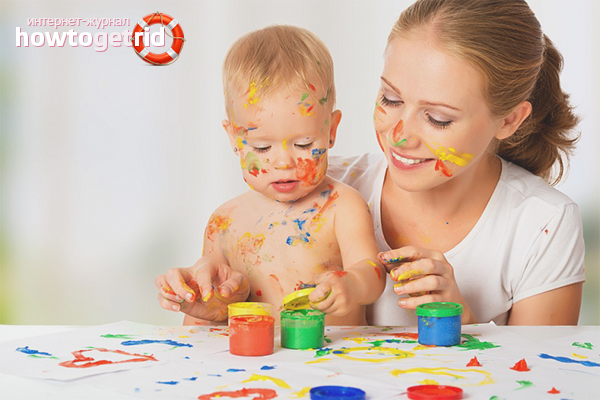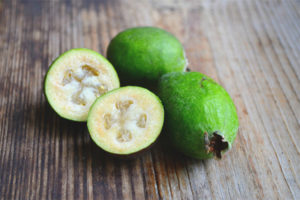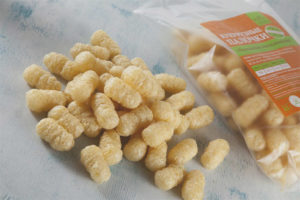The content of the article
A few decades ago there was no such thing - finger paints. In childhood, we only painted with a brush, maximum - with a cotton swab and other objects. The modern stationery industry offers finger paints - interesting, exciting, and most importantly - safe!
The benefits of finger paints
Today paints are painted from a very young age, even up to a year. This is not surprising, every mother wants to develop her child, to raise an aesthetic principle in him. Introduction to creativity is a long way, but do not limit it to age. Already in infancy, a child can find favorite colors, draw obscure shapes and pictures. It is very interesting to mix paints with each other and get unusual shades.
In addition to artistic education, drawing with finger paints is a training in fine motor skills. And this, in turn, gives a powerful impetus to the development of the child’s speech.
Drawing is also a whole bunch of positive thoughts and emotions. A rare baby will remain indifferent with such a fun pastime. Drawing teaches many hyperactive kids to be attentive, focused, assiduous. In addition, finger paints are very easy to wash and wash, which makes their use even more convenient and practical.
How to choose finger paints
You should not immediately take a large palette of colors. Before the first use, buy 4-5 bright shades that will appeal to the child. After all, at first it is important to introduce the child, but what if he does not like it? Given that paints quickly deteriorate, you do not need to throw money away.
When choosing a paint, pay attention to the consistency of the liquid. Paint should be fluid, moderately thick. Buy paint from large and trusted manufacturers.
How to prepare for drawing
This is almost the main question that worries many parents. The degree of preparation determines the cleanliness of the room after drawing, as well as the interest of parents in repeating the experiment.
First, select the place where the painting will take place. It is better to always draw in the same place, so that subsequently the child does not go beyond the designated framework. It can be a table or a corner on the floor. If you draw on the floor, remove carpets and paths, you can cover them with oilcloth. It is also better to cover the sofa and other upholstered furniture with oilcloth. As a canvas for drawing, whatman or large sheets of A3 format is best suited. Ordinary album leaves for sure will not be enough for your kid’s creativity flight.
Before drawing, put on yourself and the baby clothes that are not a pity. Paints are easy to clean, but safety net does not hurt anyone. If it’s warm at home, you can let your baby right in panties or a diaper - it will be easier to wash. Also in art stores you can buy a special waterproof apron that will protect you from paint.
How to draw with finger paints
When everything is ready, you can begin the process of drawing.
- Dip your finger in the paint and show the child that it is absolutely safe. Swipe your finger across the paper.
- If the child is interested, dip his finger and also draw on paper.
- After that, let the baby take the initiative - let him choose the right paint and make a few strokes.
- Do not forget to repeat the name of the flowers - this way the child will remember them better.
- When the child is well acquainted with the colors, you can draw certain pictures. Show the kid how to draw the sun. Let it be a simple yellow blot at the top of the Whatman paper - praise the child and his work.
- Little children can successfully draw rain or snow. You need to draw a cloud and show how to put a finger and say “Cap-cap”. To draw such a rain of blue color will be very exciting.
- You can try all the colors by drawing a rainbow. Just swipe the crumbs with your hand along one trajectory, alternately dipping your fingers in different colors.
- You can make a bouquet of palm prints. To do this, moisten the palm in one ink and make a print of this palm on paper. Repeat prints in different colors in the same way. Then draw stems and leaves to the makeshift palms, you will get a charming bouquet.
- Make a memory imprint of the handle and legs of the child. Subsequently, this picture can be dried and saved for many years to come. And you can also make an imprint as the child grows - you can see for yourself how quickly and intensively your baby grows.
- After drawing, dry the painting and hang it in a conspicuous place. The child will be proud of his work. And it’s also a wonderful present for a grandmother or grandfather from a little peanut. Show the picture in the evening to dad so that he must praise his young artist.
You can make finger paints yourself - mix water, oil and flour so that a thick mixture is obtained. As a coloring pigment, you can take saturated vegetable and fruit juices. And in order to discourage the child's desire to try paint, a large amount of salt is added to it.
Finger paints are an opportunity for a child to express their emotions and feelings. Give your kid creative freedom - let him draw!
Video: how to draw with finger paints











Submit